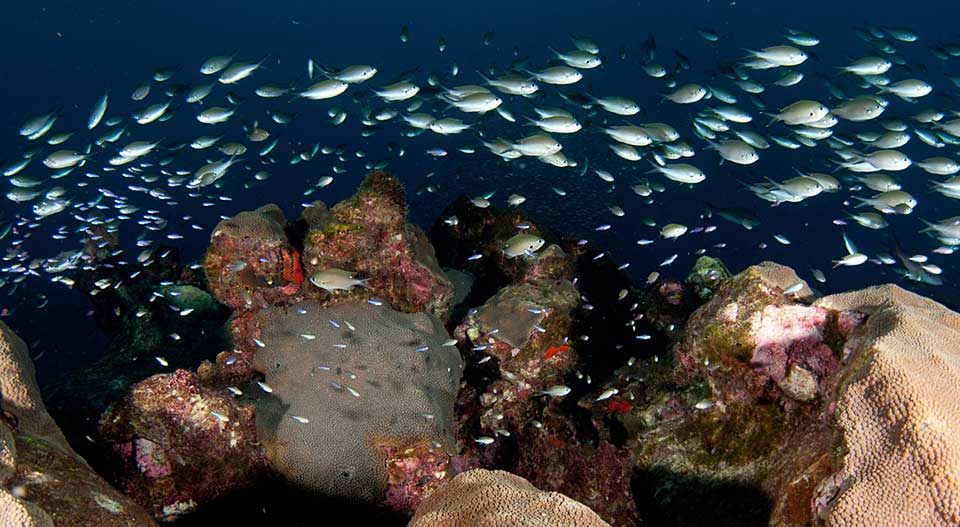U.S. Marine Biodiversity Observing Network:
Building Global Connections
Closely monitoring marine life at home, around the world is key to better understand our changing ocean.

Tracking An Ocean of Marine Life
Marine biodiversity—the variety and variability of life in the ocean—can be an early indicator of change, provided it's noticed. The U.S. Marine Biodiversity Network (MBON) aims to ensure that scientists not only notice changes in biodiversity at locations around the nation, but also have the tools in place to better understand what these changes tell us about ocean health over time. But marine life doesn't know borders. That's why the U.S. network is also expanding international cooperation with other marine biodiversity networks around the world.
One of the best ways to understand how our ocean is changing is to closely monitor the health and diversity of marine life. Armed with this knowledge, researchers can better track the health of ocean ecosystems. This, in turn, helps us make better decisions to protect marine resources and support the people and businesses who depend upon the ocean for their lives and livelihood. But monitoring marine life is no easy task. Through the U.S. Integrated Ocean Observing System, NOAA is developing a U.S. Marine Biodiversity Network through three pilot programs around the nation to create a better long-term system to monitor changes in marine life.
At the same time, U.S. MBON researchers are growing relationships with marine biodiversity networks around the world. Why? The ocean doesn't recognize borders. While NOAA and partners are working to strengthen local and regional networks in the U.S., researchers are also looking past our nation's borders to help ensure marine life data is shared around the globe.
In 2016, marine biodiversity was officially declared a thematic node within the Group on Earth Observations Biodiversity Observing Network (GEO BON). The first major undertaking of this group was to establish MBON Pole-to-Pole, an initiative to link regional observing networks in the Atlantic and Pacific to create an integrated picture of ocean status from the Arctic to the Antarctic. MBON Pole-to-Pole is now beginning work in the Americas region, with representation from U.S. MBON and participants from Argentina, Brazil, Chile, Colombia, Mexico, Ecuador, Peru, Uruguay, Venezuela, and Canada.
More recently, the Biology and Ecosystems Panel of the Global Ocean Observing System, the Ocean Biogeographic Information System, and the Marine Biodiversity Observation Network of the Group on Earth Observations Biodiversity Observation Network announced an agreement to support a sustained, coordinated, global ocean system of marine biological and ecosystem observations as part of a comprehensive global ocean observing system.
These steps to further tie together marine biodiversity networks around the world will help researchers better and more quickly detect changes in the ocean; develop, refine, and export technologies to help better manage our ocean resources; and maintain the health of our ocean for future generations.
Partnerships
U.S. MBON is a partnership among NOAA, NASA, the Bureau of Ocean Energy Management, and the U.S. Integrated Ocean Observing System. MBON partners are working to integrate with other efforts, including NOAA's National Marine Sanctuaries program, the Ocean Biogeographic Information System, the Global Ocean Observing System, and the Group on Earth Observations Biodiversity Observation Network to make data available and accessible locally, nationally, and globally.
MBON in Action
When an unprecedented coral mortality event hit Flower Garden Banks in the summer of 2016, MBON took action to help unlock the mystery. Once the dying coral was spotted, Frank Muller-Karger, MBON Principal Investigator and Director of the Institute for Marine Remote Sensing (IMaRS) at the University of South Florida, analyzed historical satellite data of the region and researchers identified unusually high levels of chlorophyll in the water around the affected coral. This, in turn, indicated unusually high runoff from the Mississippi Delta—which makes sense in the wake of higher-than-normal summer rains in the southern U.S. The runoff extended all the way to sections of the reef, and may have brought with it organic deposits and decreased light penetration that may have triggered a number of deadly consequences such as bacteria or pathogen growth. While scientists continue to work to identify the coral killer, biological observations provided the first real lead.
